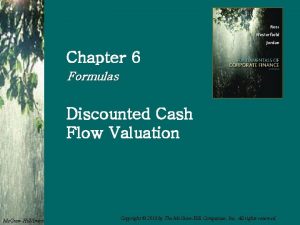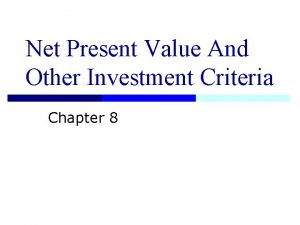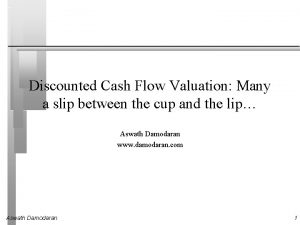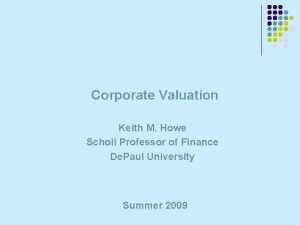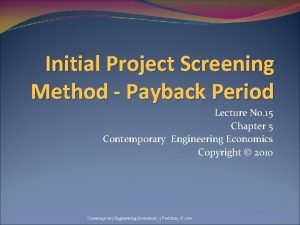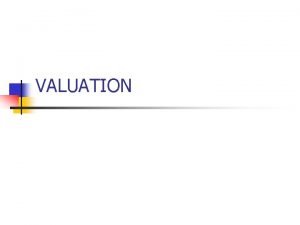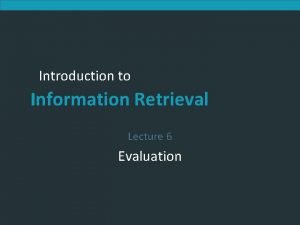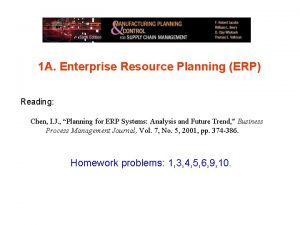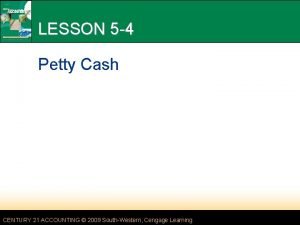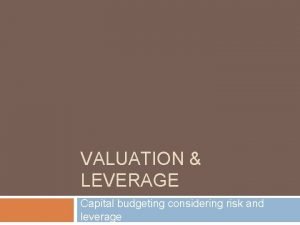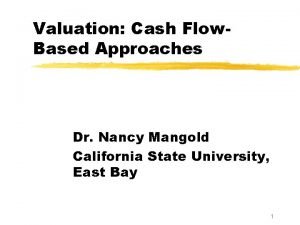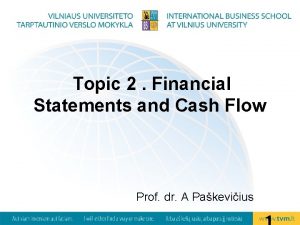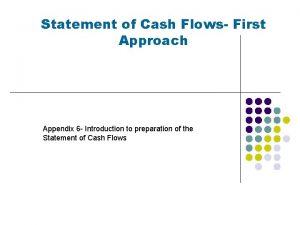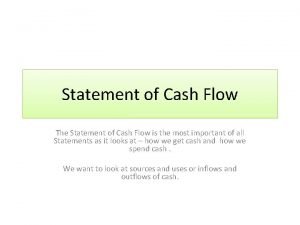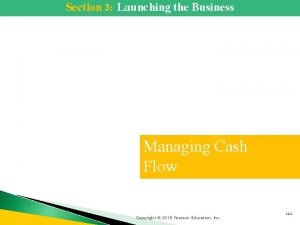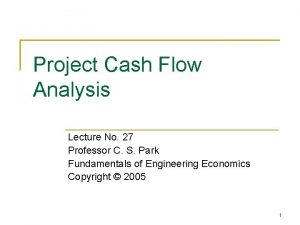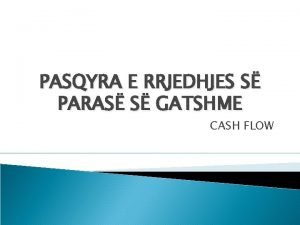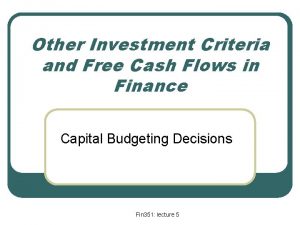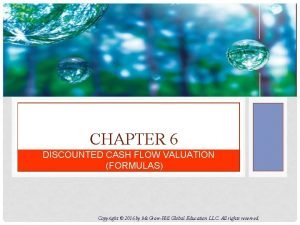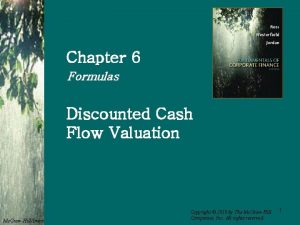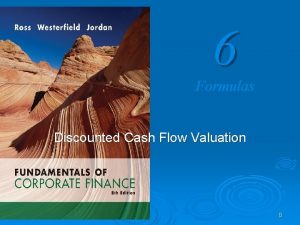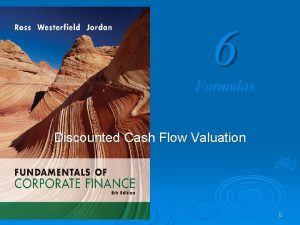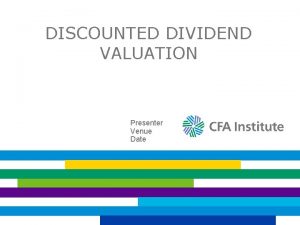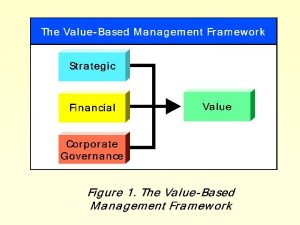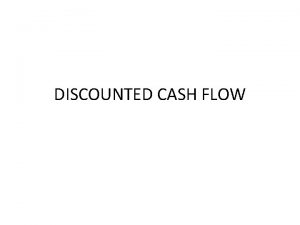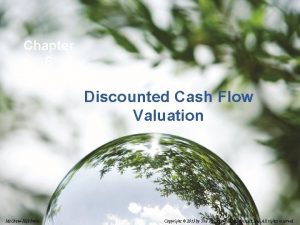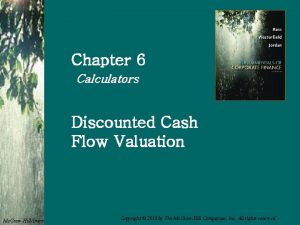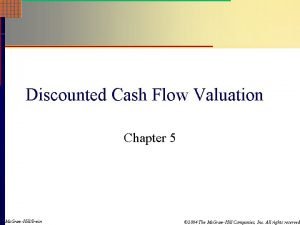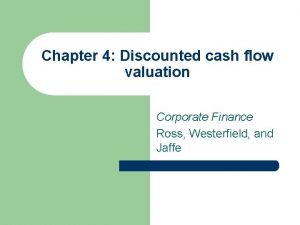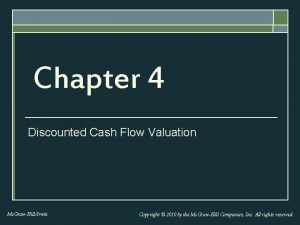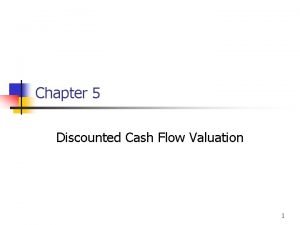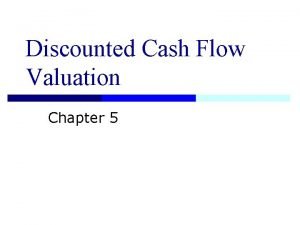Chapter 6 Formulas Discounted Cash Flow Valuation Mc



































- Slides: 35

Chapter 6 Formulas Discounted Cash Flow Valuation Mc. Graw-Hill/Irwin Copyright © 2010 by The Mc. Graw-Hill Companies, Inc. All rights reserved.

Key Concepts and Skills • Be able to compute the future value of multiple cash flows • Be able to compute the present value of multiple cash flows • Understand how interest rates are quoted 6 F-2

Chapter Outline • Future and Present Values of Multiple Cash Flows • Valuing Level Cash Flows: Annuities and Perpetuities 6 F-3

Multiple Cash Flows –Future Value - Example 6. 1 • You think you will be able to deposit $4, 000 at the end of each of the next three years in a bank account paying 8% interest. You currently have $7, 000 in the account. How much will you have in three years? In four years?

Multiple Cash Flows – Future Value Example 6. 1 • Find the value at year 3 of each cash flow and add them together FV = PV(1 + r)t – – Today (year 0): FV = 7000(1. 08)3 = 8, 817. 98 Year 1: FV = 4, 000(1. 08)2 = 4, 665. 60 Year 2: FV = 4, 000(1. 08) = 4, 320 Year 3: value = 4, 000 – Total value in 3 years = 8, 817. 98 + 4, 665. 60 + 4, 320 + 4, 000 = 21, 803. 58 – Value at year 4 = 21, 803. 58(1. 08) = 23, 547. 87 6 F-5

Multiple Cash Flows – Future Value - Example 2 • Suppose you invest $500 in a mutual fund today and $600 in one year. If the fund pays 9% annually, how much will you have in two years? – FV = PV(1 + r)t – FV = 500(1. 09)2 + 600(1. 09) = 1, 248. 05 6 F-6

Multiple Cash Flows – Example 2 (Cont’d) • How much will you have in 5 years if you make no further deposits? FV = PV(1 + r)t • First way: – FV = 500(1. 09)5 + 600(1. 09)4 = 1, 616. 26 • Second way – use value at year 2: – FV = 1, 248. 05(1. 09)3 = 1, 616. 26 6 F-7

Multiple Cash Flows – Future Value Example 3 • Suppose you plan to deposit $100 into an account in one year and $300 into the account in three years. How much will be in the account in five years if the interest rate is 8%? – FV = PV(1 + r)t – FV = 100(1. 08)4 + 300(1. 08)2 = 136. 05 + 349. 92 = 485. 97 6 F-8

Multiple Cash Flows – Present Value Example 6. 3 • You are offered an investment that will pay you $200 in one year, $400 the next year, $600 the next year and $800 at the end of the fourth year. You can earn 12 percent on very similar investments. What is the most you should pay for this one?

Multiple Cash Flows – Present Value Example 6. 3 • Find the PV of each cash flows and add them PV = FV / (1 + r)t – Year 1 CF: 200 / (1. 12)1 = 178. 57 – Year 2 CF: 400 / (1. 12)2 = 318. 88 – Year 3 CF: 600 / (1. 12)3 = 427. 07 – Year 4 CF: 800 / (1. 12)4 = 508. 41 – Total PV = 178. 57 + 318. 88 + 427. 07 + 508. 41 = 1, 432. 93 6 F-10

Example 6. 3 Timeline 0 1 200 2 3 4 400 600 800 178. 57 318. 88 427. 07 508. 41 1, 432. 93 6 F-11

Multiple Cash Flows – Present Value Another Example • You are considering an investment that will pay you $1, 000 in one year, $2, 000 in two years and $3, 000 in three years. If you want to earn 10% on your money, how much would you be willing to pay? PV = FV / (1 + r)t – – PV = 1000 / (1. 1)1 = 909. 09 PV = 2000 / (1. 1)2 = 1, 652. 89 PV = 3000 / (1. 1)3 = 2, 253. 94 PV = 909. 09 + 1, 652. 89 + 2, 253. 94 = 4, 815. 92 6 F-12

Quick Quiz – Part I • Suppose you are looking at the following possible cash flows: Year 1 CF = $100; Years 2 and 3 CFs = $200; Years 4 and 5 CFs = $300. The required discount rate is 7%. • What is the value of the cash flows at year 5? • What is the value of the cash flows today? 6 F-13

Annuities and Perpetuities Defined • Annuity – finite series of equal payments that occur at regular intervals – If the first payment occurs at the end of the period, it is called an ordinary annuity – If the first payment occurs at the beginning of the period, it is called an annuity due • Perpetuity – infinite series of equal payments 6 F-14

Annuities and Perpetuities – Basic Formulas • Perpetuity: PV = C / r • Annuities: 6 F-15

Annuity – Example 6. 5 • After carefully going over your budget, you have determined you can afford to pay $632 per month towards a new sports car. You call up your local bank and find out that the going rate is 1 percent per month for 48 months. How much can you borrow?

Annuity – Example 6. 5 • You borrow money TODAY so you need to compute the present value. • Formula: 6 F-17

Annuity – Sweepstakes Example • Suppose you win the Publishers Clearinghouse $10 million sweepstakes. The money is paid in equal annual installments of $333, 333. 33 over 30 years. If the appropriate discount rate is 5%, how much is the sweepstakes actually worth today? 6 F-18

Quick Quiz – Part II • You want to receive 5, 000 per month in retirement. If you can earn 0. 75% per month and you expect to need the income for 25 years, how much do you need to have in your account at retirement? 6 F-19

Finding the Payment • Suppose you want to borrow $20, 000 for a new car. You can borrow at 8% per year, compounded monthly (8/12 =. 66667% per month). If you take a 4 year loan, what is your monthly payment? C = 488. 26 6 F-20

Finding the Number of Payments – Example 6. 6 • You ran a little short on your spring break vacation, so you put $1, 000 on your credit card. You can afford only the minimum payment of $20 per month. The interest rate on the credit card is 1. 5% per month. How long will you need to pay off the $1, 000?

Finding the Number of Payments – Example 6. 6 Use logarithms because you are solving an equation in which the unknown occurs as a power – – – – – First divide both sides of the equation by 20 50 = 1 – 1/1. 015 t /. 015 50 x. 015 =1 – 1 / 1. 015 t 0. 75 = 1 – 1 / 1. 015 t 1/1. 015 t = 1 – 0. 75 1/1. 015 t = 0. 25 1/0. 25 = 1. 015 t 4 = 1. 015 t Taking logarithm of both sides t = ln(4) / ln(1. 015) = 93. 111 months = 7. 76 years 6 F-22

Finding the Number of Payments – Example 6. 6 • Alternatively,

Finding the Number of Payments – Another Example • Suppose you borrow $2, 000 at 5%, and you are going to make annual payments of $734. 42. How long before you pay off the loan? – – – – – 2, 000 = 734. 42(1 – 1/1. 05 t) /. 05 First divide both sides of the equation by 734. 42 2. 723237 = 1 – 1/1. 05 t /. 05 2. 723237 x. 05 = 1 – 1/1. 05 t. 136161869 = 1 – 1/1. 05 t = 1 –. 136161869 1/1. 05 t =. 863838131 1/. 863838131 = 1. 015 t 1. 157624287 = 1. 05 t t = ln(1. 157624287) / ln(1. 05) = 3 years 6 F-24

Finding the Number of Payments – Another Example • Alternatively,

Quick Quiz – Part III • You want to receive $5, 000 per month for the next 5 years. How much would you need to deposit today if you can earn 0. 75% per month? • Suppose you have $200, 000 to deposit and can earn 0. 75% per month. – How many months could you receive the $5, 000 payment? – How much could you receive every month for 5 years? 6 F-26

Future Values for Annuities • Suppose you begin saving for your retirement by depositing $2, 000 per year in an individual retirement account (IRA). If the interest rate is 7. 5%, how much will you have in 40 years? FV = 454, 513. 04 6 F-27

Annuity Due • You are saving for a new house, and you put $10, 000 per year in an account paying 8%. The first payment is made today. How much will you have at the end of 3 years? 6 F-28

Perpetuity – Example • An investment offers a perpetual cash flow of $500 every year. The return you require on such an investment is 8%. What is the value of this investment? • Perpetuity formula: PV = C / r = $500 /. 08 = $6, 250 6 F-29

Quick Quiz – Part IV • You want to have $1 million to use for retirement in 35 years. If you can earn 1% per month, how much do you need to deposit on a monthly basis if the first payment is made in one month? • What if the first payment is made today? • You are considering preferred stock that pays a quarterly dividend of $1. 50. If your desired return is 3% per quarter, how much would you be willing to pay? 6 F-30

Growing Annuity A growing stream of cash flows with a fixed maturity 6 F-31

Growing Annuity: Example A defined-benefit retirement plan offers to pay $20, 000 per year for 40 years and increase the annual payment by three-percent each year. What is the present value at retirement if the discount rate is 10 percent? 6 F-32

Growing Perpetuity A growing stream of cash flows that lasts forever 6 F-33

Growing Perpetuity: Example The expected dividend next year is $1. 30, and dividends are expected to grow at 5% forever. If the discount rate is 10%, what is the value of this promised dividend stream? 6 F-34

End of Chapter 6 F-35
 Chapter 6 discounted cash flow valuation
Chapter 6 discounted cash flow valuation Profitability index formula
Profitability index formula Discounted cash flow
Discounted cash flow Discounted cash
Discounted cash Valuation of bonds
Valuation of bonds Cffa finance formula
Cffa finance formula Discounted payback period formula
Discounted payback period formula Payback time formula
Payback time formula Advantages of capital budgeting
Advantages of capital budgeting Discounted abnormal earnings model
Discounted abnormal earnings model Old mutual wealth discounted gift trust
Old mutual wealth discounted gift trust Discounted rate of return
Discounted rate of return Mean average precision information retrieval
Mean average precision information retrieval Discounted gift trust
Discounted gift trust Cash to cash cycle time
Cash to cash cycle time Cash to cash cycle time
Cash to cash cycle time Cash-in cash-out
Cash-in cash-out Which budget shows anticipated cash flows
Which budget shows anticipated cash flows Paid cash to establish a petty cash fund
Paid cash to establish a petty cash fund Cash control systems
Cash control systems 9 chemical names and formulas
9 chemical names and formulas What is interest tax shield
What is interest tax shield Residual cash flow
Residual cash flow Change in nwc equation
Change in nwc equation Cash flow adjustments
Cash flow adjustments Salaries paid in cash flow statement
Salaries paid in cash flow statement Strategic assessment in software project management
Strategic assessment in software project management Discount cash flow method
Discount cash flow method Difference between cash flow and revenue
Difference between cash flow and revenue Cash flow table
Cash flow table Private equity cash flow forecasting
Private equity cash flow forecasting Free cash flow to firm
Free cash flow to firm Disadvantage of using a safe deposit box
Disadvantage of using a safe deposit box Pasqyra e mjeteve monetare
Pasqyra e mjeteve monetare Pasqyra cash flow
Pasqyra cash flow Incremental cash flows
Incremental cash flows
